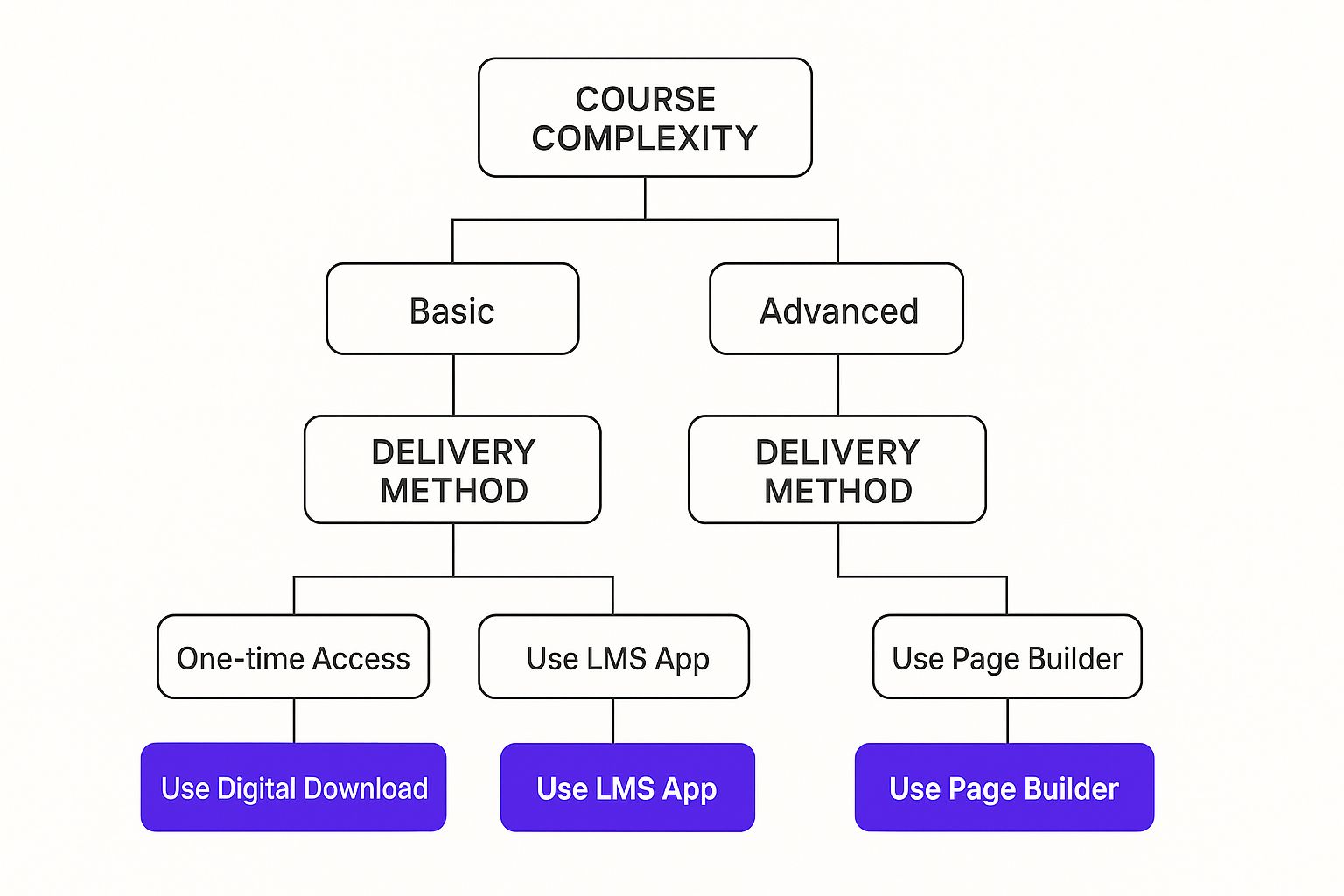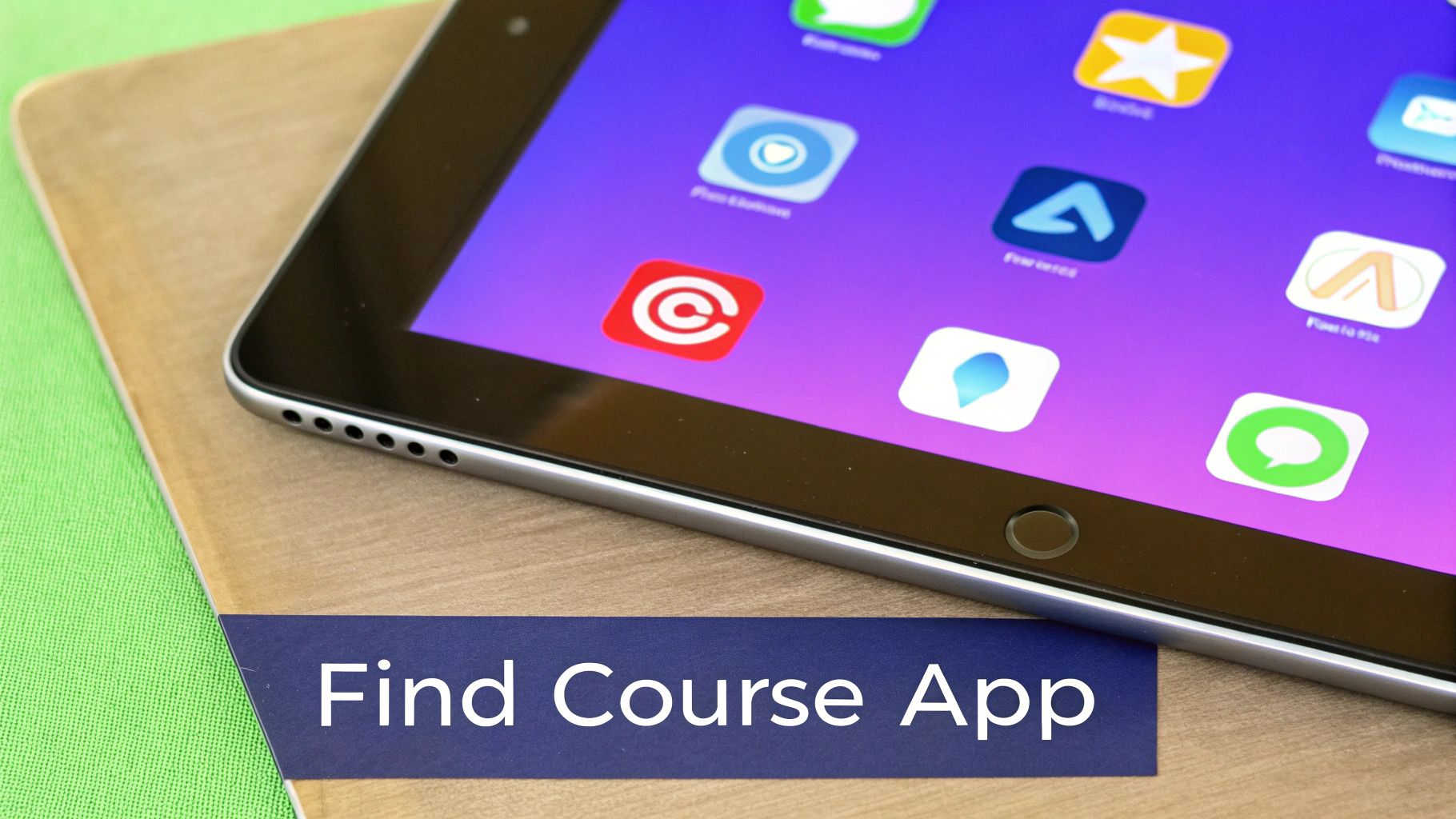Why Shopify Is Your Gateway to the Course Creation Economy
The online education world is booming, and Shopify is becoming the platform of choice for creators looking to tap into this growth. More than just an eCommerce platform, Shopify provides a comprehensive system for educators to connect with students around the world and cultivate their own brand. This is a stark contrast to typical course platforms, which often restrict branding, pricing, and overall growth.
Reaching a Global Audience and Building Your Brand
One of the biggest perks of selling courses on Shopify is its massive global reach. Shopify stores have facilitated approximately $1 trillion in global sales online, highlighting the huge market potential for course creators. This reach is expanding rapidly, with 30% more global merchants joining the platform in the first half of 2024. This growing marketplace offers incredible opportunities for course creators to reach students everywhere. Find more detailed statistics here. Plus, Shopify allows you to develop your own unique brand identity, unlike some platforms that limit customization. This means you can design your online storefront, marketing, and course presentation to connect with your specific target audience.
Flexible Pricing and Bundling for Maximized Value
Shopify also offers flexible pricing models. Imagine building with LEGOs: you can create different pricing structures – single course purchases, subscriptions, bundles, and memberships – to meet diverse student needs and budgets. For example, you might offer a beginner's course as a single purchase while bundling advanced courses with exclusive community access through a membership. This modular approach lets you maximize revenue and cultivate lasting relationships with your students. Traditional platforms often lack this level of flexibility, restricting your ability to experiment with pricing and bundling strategies.
Leverage Shopify's Infrastructure for Innovative Offerings
Innovative creators are using Shopify's infrastructure to develop new ways to improve the student experience and build a thriving learning community. For example, you can develop exclusive membership programs that offer ongoing support, resources, and networking opportunities for students who complete your courses. This can be incredibly helpful for complex subjects where continued guidance is key. This approach transforms your courses from one-time purchases into ongoing learning journeys, fostering loyalty and maximizing long-term customer value. It's a win-win: students receive continued support, and you build a sustainable and successful education business.
Architecting Your Shopify Store for Course Success

Building a successful online course business on Shopify requires more than just uploading your content. It takes a strategic design approach, focused on converting curious browsers into enrolled students. This involves understanding effective layout psychology, choosing the right themes, and optimizing the checkout process for various payment options.
Homepage Design: First Impressions Matter
Your homepage is like the digital storefront for your courses. A cluttered layout can lead to high bounce rates, meaning potential students leave before exploring your offerings. Think of a physical bookstore: an inviting space encourages browsing, while a messy one discourages customers.
- Showcase Your Best: Feature your most popular courses prominently.
- Clear Value Proposition: Clearly communicate the benefits of your courses – the problems they solve and the student transformations they offer.
- Compelling Call to Action: Use concise calls to action, such as "Enroll Now" or "Learn More," to guide visitors.
Product Pages: Turning Interest into Enrollment
Your course product pages are crucial. They transform initial interest into purchasing decisions. Here, you showcase the full value of your courses and streamline the buying process.
- Detailed Course Descriptions: Offer in-depth information about the curriculum, learning objectives, and student achievements.
- High-Quality Visuals: Use engaging images and videos to showcase the learning experience.
- Student Testimonials and Social Proof: Display positive reviews and testimonials to build trust and credibility. These online testimonials function like word-of-mouth referrals, reassuring potential students.
- Simplified Checkout Process: Minimize the steps to purchase, reducing cart abandonment. Streamlined checkouts contribute to higher conversion rates, leading to increased enrollment.
Choosing the Right Shopify Theme for Selling Courses on Shopify
The right Shopify theme is vital for showcasing your courses effectively. Some are specifically designed for digital products, with features like integrated course listings and streamlined checkouts.
- Mobile Responsiveness: Ensure your theme works well on all devices (phones, tablets, etc.), as many students will access your courses this way. A poor mobile experience can lead to lost sales.
- Page Load Speed: A fast-loading website is crucial. Slow loading times can deter students and impact search engine ranking.
- Customization Options: Find a theme that offers customization, allowing you to match your brand identity.
By architecting your Shopify store carefully, focusing on conversion-oriented design and payment optimization, you create a smooth transition from browsing to enrollment. This strategic approach boosts sales and fosters a positive learning experience, setting the stage for lasting success in the online course market. This means you can use Shopify to build a thriving online education business.
Selecting Your Perfect Course Delivery Approach
Choosing the right way to deliver your courses on Shopify is a big deal. It affects everything from how happy your students are to how successful your business becomes. The key is finding a balance between a great learning experience and a platform that's easy to manage. Let's explore how successful educators are making this happen.
Balancing Student Experience and Technical Simplicity
Many course creators struggle to find that perfect balance between a rich, engaging learning experience and a platform that's easy to use. Systems that are too complicated can cause technical headaches for both you and your students. Imagine trying to learn new software while also trying to figure out a confusing course platform. Frustrating, right? This is why picking an approach that works seamlessly with Shopify is so important. This integration simplifies the learning process and reduces administrative work.
Integrations That Drive Completion and Satisfaction
Some integrations are better than others when it comes to student completion rates and satisfaction scores. Platforms with seamless progress tracking, interactive quizzes, and downloadable resources tend to keep students more engaged. These features, like milestones on a road trip, give students a sense of accomplishment and encourage them to keep learning. A strong community feature can also make a big difference, helping students connect with each other and offer support. It's like joining a hiking group – the shared experience makes the journey more enjoyable and motivating.
Hidden Technical Considerations
There are several behind-the-scenes technical aspects that can affect your course delivery. Protecting your content is crucial. You've put time and effort into creating valuable material, and strong security measures protect your intellectual property. Being able to offer various content formats, such as videos, downloadable workbooks, and live Q&A sessions, keeps students engaged and caters to different learning styles. This variety creates a dynamic learning experience and makes sure everyone can access the content.
Choosing the Right Delivery Method for Your Courses
Figuring out the best way to deliver your courses can be overwhelming. To make it easier, we’ve created a decision tree to guide you. The decision tree below helps you visualize the key decision points and outcomes, leading you to the right platform for your needs and course vision. You may also be interested in: How to master course creation on Shopify.

This decision tree allows you to map out the optimal path for your course delivery. As the decision tree shows, factors like course format, technical skills, budget, and desired student interaction all play a role in selecting the right method.
Using the Decision Tree
This decision tree acts like a personalized roadmap. Begin at the top with the main question about your course format. Are you offering a live workshop, a self-paced course, or a combination? Each answer leads you down a different path. As you go through the tree, think about things like your technical skills, budget, and how much interaction you want your students to have.
Key Decision Points and Outcomes
The tree highlights key decisions, including your preferred hosting platform, your content protection needs, and how much community interaction you want. The final outcomes suggest specific platforms and best practices based on your answers. The goal is to choose a delivery approach that perfectly matches your vision and allows you to create a great learning experience for your students while maximizing your success on Shopify. This strategic decision is the foundation of a thriving online education business.
To further clarify your options, let's examine a comparison of popular course delivery solutions:
To help you choose the right platform for your needs, here's a comparison table of different course delivery solutions for Shopify:
Course Delivery Solutions for Shopify: Comparison of different methods to deliver course content through Shopify
| Solution | Best For | Key Features | Pricing | Limitations |
|---|---|---|---|---|
| Tevello | Shopify users wanting integrated courses | Direct Shopify integration, community features, course bundling | $29/month | Dependent on Shopify’s Infrastructure |
| Thinkific | Creators seeking a dedicated platform | Course creation tools, student management, community features | Varies based on plan | Requires integration with Shopify for sales |
| Teachable | Creators focused on building a brand | Customizable branding, marketing tools, affiliate program | Varies based on plan | Requires integration with Shopify for sales |
| Podia | Creators offering multiple digital products | Membership options, email marketing, selling digital downloads | Varies based on plan | Requires integration with Shopify for sales |
| Custom Solution (using apps like LearnWorlds or Kajabi) | Creators needing highly specialized features | Tailored functionality, advanced integrations | Varies based on platform and development costs | Can be complex to set up and manage |
This table highlights some popular choices, ranging from dedicated course platforms to integrated Shopify apps. Each solution offers a different set of features and pricing. Consider your budget, technical skills, and the level of customization you need when making your choice. Ultimately, the best platform is the one that empowers you to create a rewarding learning experience for your students and supports your business goals.
Crafting Irresistible Course Pricing Strategies
Pricing your online course on Shopify isn't just about picking a number; it's a strategic process that blends market research with an understanding of what makes students click that "buy" button. The right price can significantly impact your enrollments and revenue. It's all about understanding student motivations and presenting your pricing in a way that encourages purchases.
Psychological Pricing Triggers
Let's talk about psychological pricing. Pricing your course at $97 instead of $100 can subtly suggest a bargain, even though the difference is small. This is called charm pricing, and it leverages our tendency to focus on the first digits of a price. Clearly communicating the value your course offers – the transformation students can expect – can also justify the investment and overcome price objections. Want to learn more? Check out this helpful resource: How to master online course pricing.
Tiered Offerings and Bundling Strategies
Tiered pricing allows you to cater to a broader audience. Consider offering a basic package, a premium package with bonus content, and a VIP package with personalized coaching. This approach captures different market segments, from budget-conscious learners to those seeking a high-touch experience.
Bundling courses together can also increase perceived value and encourage bigger purchases. Offering a beginner, intermediate, and advanced course as a discounted bundle, for example, can incentivize students to invest in their long-term learning journey with you.
Payment Plans and Promotions
Payment plans make your courses more accessible. By breaking down a larger price into smaller installments, you remove the hurdle of a large upfront cost and often see higher conversion rates.
Strategic promotions can also boost enrollments. Limited-time offers or early-bird discounts create a sense of urgency and encourage immediate action. Keep your promotions genuine and value-driven, though. Avoid tactics that might feel manipulative. Returning customer rates average 27%, highlighting the potential for repeat business with the right engagement strategies. Average cart values during sales events like Black Friday and Cyber Monday reached $108.12 in 2023, demonstrating that customers are willing to invest in digital products presented effectively. Explore this topic further.
Pricing Evolution for Sustainable Growth
Your pricing strategy should not be static. As you gain experience, gather student feedback, and improve your course content, adjust your prices to reflect the increased value you offer. Analyzing the pricing strategies of other successful course creators can also offer valuable insights. This iterative approach ensures your pricing remains competitive while maximizing initial sales and long-term, sustainable growth. Focusing on value, combined with understanding your target audience, will build a thriving online course business on Shopify.

Building Multi-Channel Course Marketing Engines
Selling courses on Shopify opens up a world of marketing opportunities. But simply having a Shopify store isn't enough. You need a robust marketing engine to consistently attract and convert potential students. This means going beyond general marketing advice and developing strategies specifically for educational products.
Content Marketing That Converts
One of the most effective ways to market online courses is through content marketing. This involves creating valuable, free content related to your course topic. This establishes you as an expert and attracts potential students.
For example, if you sell a photography course, you could create blog posts, YouTube videos, or Instagram posts offering photography tips and tricks. This free content acts as a lead magnet, attracting a targeted audience interested in what you offer. By providing value upfront, you build trust and demonstrate your expertise, making potential students more likely to purchase your paid course.
Email Marketing for Nurturing Leads
Once you've attracted leads through content marketing, email marketing becomes essential. Think of your email sequence as a personalized guide, leading prospects through the buying process.
Start by offering a valuable lead magnet, like a free checklist or mini-course, in exchange for their email address. Then, nurture these leads with emails that provide additional value, address their pain points, and showcase the benefits of your course. Top performers use targeted email sequences to build relationships, address objections, and ultimately guide subscribers towards enrollment.
Leveraging Social Proof and Launch Momentum
Successful launch campaigns often use social proof to create excitement and drive enrollments. Testimonials from early students, limited-time offers, and a sense of community all contribute to a buzz around your course.
Think of a successful product launch like a snowball rolling downhill – it starts small but gathers momentum. By creating a feeling of excitement and scarcity, you encourage potential students to enroll quickly.
Optimizing Your Marketing Channels for ROI
Not all marketing channels are created equal. It's crucial to identify your most effective channels and optimize them for maximum return on investment (ROI). This involves tracking your results, testing different approaches, and focusing your efforts where they yield the greatest returns.
The ability to connect online stores to multiple sales channels, a practice adopted by 90% of Shopify merchants, enhances the visibility and reach of courses. This strategic diversification helps course sellers target a broader audience across different markets, leveraging Shopify's global presence in major markets like the U.S., U.K., Australia, Canada, and Germany. Discover more insights about Shopify statistics. You might be interested in: How to master building community for Shopify courses. By understanding which channels resonate most with your target audience, you can allocate your resources effectively and maximize your marketing impact. This targeted approach ensures your marketing efforts are focused and efficient, driving consistent growth for your online course business.
Maximizing Enrollment During Peak Buying Seasons
Timing is everything when selling courses on Shopify. Just like brick-and-mortar stores experience sales increases during holidays, online courses see enrollment spikes during specific times. Understanding these peak buying seasons is crucial for maximizing your revenue.

Aligning With Natural Buying Cycles
Analyzing enrollment patterns reveals predictable spikes throughout the year. For instance, the New Year often brings a surge in self-improvement, making it a prime time for personal development courses.
The back-to-school season also presents a great opportunity. This period sees increased interest in academic, professional development, and even creative courses. Tapping into these natural cycles is key for strategic course promotion.
Crafting Irresistible Limited-Time Offers
Capitalize on peak seasons with limited-time offers. These could include discounts, bonus materials, or exclusive community access. Creating a sense of urgency can significantly boost enrollments.
However, maintain a balance. While urgency can be effective, it's important to preserve the perceived value of your courses. Don't undervalue your expertise!
Promotional Frameworks for Peak Periods
Driving enrollment requires a multi-faceted approach. Strategic email sequences can remind potential students about upcoming deadlines or highlight the benefits of enrolling. Optimizing landing pages is also essential.
- Targeted Email Campaigns: Segment your audience and personalize messages.
- Optimized Landing Pages: Communicate the value of your courses clearly and simplify enrollment.
- Social Media Promotions: Use platforms like Facebook and Instagram to reach your target audience.
Preparing for Traffic Surges
High-traffic periods can stress your infrastructure. Ensuring your website and payment gateway can handle the increased demand is paramount. Shopify is known for its robustness, handling $11.5 billion in sales during Black Friday and Cyber Monday in 2024, a 24% increase year-over-year.
This surge demonstrates the platform’s capability. More detailed statistics are available here. Preparing for increased traffic prevents lost sales and ensures a positive student experience. A strong customer support system can also address any issues promptly.
To help you prepare, here's a table summarizing key shopping events and effective marketing strategies:
Key Shopping Events for Course Sellers: Calendar of high-conversion shopping periods with marketing strategies
| Shopping Event | Timing | Consumer Mindset | Marketing Strategy | Average Conversion Lift |
|---|---|---|---|---|
| New Year | January | Self-Improvement | Focus on resolutions, offer discounts | 15-20% |
| Back-to-School | August/September | Skill Development | Highlight career advancement, bundle offers | 10-15% |
| Black Friday/Cyber Monday | November | Deal Hunting | Deep discounts, limited-time offers | 20-30% |
| Holiday Season | December | Gifting | Promote courses as gifts, offer gift wrapping | 5-10% |
This table provides a general overview. The actual conversion lift will vary based on your specific niche and marketing efforts. Remember to track your results to optimize your strategy for future events.
Checklist for Peak Season Preparation
- Website Performance: Test your site's capacity.
- Payment Gateway: Ensure your processor can handle increased transactions.
- Customer Support: Prepare for a higher volume of inquiries.
- Inventory Management: If you offer physical products alongside your courses, ensure sufficient stock.
- Contingency Planning: Have backups in place for any unexpected issues.
By understanding buying cycles, crafting compelling offers, and preparing for increased demand, you can maximize enrollments during peak seasons and build a successful online education business on Shopify.
Scaling Your Course Empire Beyond the First Launch
Successfully launching your first online course on Shopify is a major milestone. But the journey doesn't end there. Turning that initial launch into a thriving, sustainable online education business requires a strategic approach to scaling. This means expanding your reach while simultaneously refining your course content and the processes that support it. Let's explore how to achieve this sustainable growth.
Leveraging Student Feedback for Continuous Improvement
The most successful course creators understand the value of student feedback. It provides invaluable insights into what's working well, what could be improved, and what your students are eager to learn more about. By actively seeking out and analyzing feedback, you can continually refine your curriculum, making it more effective and engaging. This iterative process ensures your courses stay relevant and valuable to your audience.
This feedback loop also helps you identify your most enthusiastic students. These satisfied learners can become your biggest advocates, driving organic growth through word-of-mouth referrals and testimonials. This type of organic promotion is essential for building trust and attracting new students.
Automating for Personalized Experiences at Scale
As your student base expands, personalizing the learning experience for each individual can become a significant challenge. This is where automation becomes incredibly useful. Think of automation as your tireless virtual assistant. It handles repetitive tasks, freeing you to focus on developing high-quality content and engaging directly with your students.
Automated email sequences, for instance, can welcome new students, deliver course materials on a schedule, and offer personalized recommendations based on their progress. This automated engagement helps foster a sense of community and keeps students motivated throughout their learning journey.
Expanding Your Offerings With Strategic Product Ladders
Many successful online course businesses utilize product ladders, offering a range of products at varying price points and levels of complexity. This strategy allows you to cater to a broader audience and increase your lifetime customer value.
Visualize a ladder: a beginner course serves as the first rung. As students progress, they can climb to intermediate and advanced courses. You can also offer supplementary materials, one-on-one coaching sessions, or access to exclusive communities as higher-level rungs on the ladder.
This tiered approach gives students a clear path for ongoing learning and development. It also diversifies your revenue streams, resulting in a more resilient and scalable business model. By strategically expanding your course offerings, you can nurture your students throughout their learning journey, maximizing both their success and the growth of your business.
Ready to elevate your Shopify course business? Tevello seamlessly integrates courses and communities directly into your Shopify store, giving you the tools to build a flourishing online education empire. Streamline your operations, improve the student experience, and unlock the full potential of your Shopify store with Tevello.




